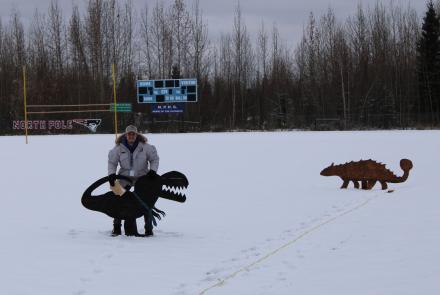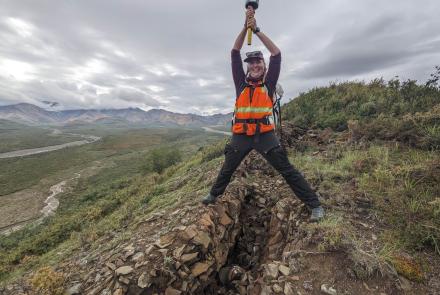Meet Ph.D. student Amy Jenson
Amy Jenson was inside a vertical shaft of Mendenhall Glacier, which smothers the mountains above Juneau and sends meltwater into a lake that sends it onward into Fritz Cove and the Gulf of Alaska.
Icy blue water up to 2 feet deep in some places and 3 feet wide rushed along beside her at the bottom of the hole, called a moulin, carved into the glacier by surface runoff. The moulin’s course changed from vertical to horizontal, allowing her to take an autumn walk along a clear stream — inside a glacier — until the tunnel narrowed.
“I ice-climbed out of the moulin at sunset, and as I peeked up over the edge I saw the sun setting over Mendenhall Lake,” she said. “It was one of the most surreal experiences.”
That was just for fun. Now glaciers are a part of her academic and research life.
Jenson is a second-year Ph.D. student at the University of Alaska Fairbanks, specializing in subglacial hydrology research through the UAF Geophysical Institute and doing her required doctoral coursework in the UAF College of Natural Science and Mathematics.
Jenson grew up on Prince of Wales Island in Southeast Alaska and completed most of her education in Alaska, going from high school in Wrangell on a neighboring island to the University of Alaska Southeast, where she obtained a bachelor’s degree in mathematics. From there she attended Montana State University, where she received her master’s in mathematics.
But as happens with many Alaskans who head to the Lower 48, Alaska was calling her home.
“I was really excited to come back to Alaska,” she said. “The research group here is well-respected in the glaciology community.”
“There are a lot of great opportunities at UAF, specifically in the glaciology group when it comes to fieldwork,” she said. “Many international researchers in many disciplines come through UAF to do field campaigns in Alaska.”
Jenson last year was one of two recipients of a two-year Geophysical Institute Schaible Fellowship. The fellowship is named after the late Grace Berg Schaible, one of the University of Alaska system’s strongest private financial supporters and who was also a UAF graduate and former Alaska attorney general.
It was at the Southeast Alaska campus where she first discovered her interest in glaciers, both personally and in research.
“At first it was mostly from being around the glaciers near Juneau — the Mendenhall and the Lemon Creek glaciers — and stories of the Juneau icefield and spending time hiking around and ice climbing on the glaciers,” she said. “I just found them really fascinating, especially the interaction with water around the glaciers.”
“I had an opportunity in my final year at UAS to work with a glaciologist there, Jason Amundson, who I did a yearlong research project with that turned into more than one year,” she said.
Jenson’s doctoral research at UAF will focus on the competing effects of subglacial hydrology and glacier geometry on ice velocities, specifically at Jakobshavn glacier in Greenland. The glacier, on the southern west coast, is known as Sermeq Kujalleq in Greenlandic.
She’ll be heading to Greenland each of the next two years as part of a science team studying how meltwater and the ocean affect glacial ice loss. The National Science Foundation is funding the project.
“I'm specifically looking at marine-terminating outlet glaciers, these really large glaciers that funnel a lot of ice into the ocean,” she said. “One of the interesting dynamics that happen in these glaciers is that during the summer we often see large speed-ups. And part of that is driven by meltwater.”
The opportunity to see such an extent of ice will be a highlight.
“I think I'm most excited about seeing the vastness of ice there,” she said. “You go to places like the Juneau icefield, and you see this expanse of ice. But Greenland is this next level of ice where it's almost a sea of ice, and Antarctica is another level beyond that.”
“To see just the scale of ice that Greenland holds will be pretty spectacular,” she said.
The Greenland research will likely lead to a published paper, but Jenson is already a published scientist.
Her paper titled “Long-period variability in ice-dammed glacier outburst floods due to evolving catchment geometry” published in January 2022 in The Cryosphere, a journal of the European Geosciences Union. That research, produced with co-author Amundson, was motivated by floods on the Mendenhall Glacier.
She gave an oral presentation at the 2021 annual meeting of the American Geophysical Union. That presentation was titled “How Do Changes in Glacier and Basin Geometry Affect the Evolution of Ice-Dammed Glacier Outburst Floods.”
Jenson has a paper under review through the European Geosciences Union regarding modeling of saline fluid flow through subglacial ice-walled channels.
On campus, Jenson is president of W*iSE, a student organization that aims to connect women and marginalized students, staff, and faculty in the sciences. The group formed in spring 2023 and has already hosted a book club, social events and a financial literacy seminar series.
“We provide opportunities for professional, social, and personal development,” she said. “We have also started a mentorship program that is open to everyone affiliated with UAF where we pair people at different career stages to learn from each other's experiences.”
Being a home-grown Alaskan may have given Jenson some early insight into the opportunities available at UAF.
“I think that UAF is a really unique place to study because it's a vibrant research community in a relatively small town,” she said. “I live in a cabin out in the woods and drive 10 minutes and don't have a single stoplight on my way to work.”
Attending a big university in a big city might mean sacrificing a little bit of your lifestyle or who you are.
“Here I can live the lifestyle I want to live while being a part of this world-renowned research group.”
Rod Boyce, University of Alaska Fairbanks Geophysical Institute, 907-474-7185, rcboyce@alaska.edu




